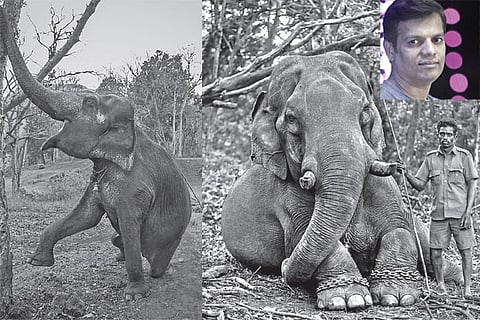

Chennai
When Senthil was 11 years old, he had a chance to visit tamed male elephants in the Mudumalai Elephant Camp. During that time, he saw a single tusker chained and separated from the rest of the group. When enquired further, the caretaker said it was recently caught from the forest untamed. This created a spark in Senthil to know more about the tuskers in the forest and the process taking place while taming the wild elephants. Now, the 40-year-old photographer is doing a photo series called Tamed Tuskers, where he documents the bond between elephants and their mahouts.
“The ecological imbalance has led to increased conflict between humans and wildlife across the country. As migratory, nomadic animals that can walk up to 20km a day in search of food and water, elephants have had their usual migration paths disrupted by farming plantations, settlements and the construction of roads and highways. As they lose their forests, the elephants increasingly come into human-inhabited lands, destroying agricultural land and crops. Elephant tamers (mahouts) from the Kurumba community, a tribe from the Western Ghats, tames these elephants. During my visit to Mudumalai Elephant Camp to take photos, I learned several stories about the tuskers and the relationships they have with their mahouts. I was astonished by it and decided to do a photo series,” says Senthil.
During his visits, the photographer noticed the kind of bonding mahouts share with tuskers. Once the elephants are captured from areas of conflict, the mahouts undergo a long process to tame and train them, eventually earning the trust of the elephant. “Some senior mahouts take care of the tuskers like their own children. During the taming process, mahouts don’t use any sharp tools or weapons instead they use a thin stick to touch and communicate with the animal. Usually, a tusker spends an entire life span with a single mahout and does not get accustomed to any new mahouts. Likewise, a mahout also spends most of the time with a single tusker. During the musth period (musth is a periodic condition in male elephants characterised by highly aggressive behaviour and accompanied by a large rise in reproductive hormones), elephants don’t listen to anyone but they only obey mahouts in such situations,” explains the lensman.
After travelling to various reserves across the country, he has developed a vast knowledge on conservation and human-animal conflicts. “Tamed Tuskers is just a small part of the documentation that I have been doing on human-elephant conflict. In the past 10 years, we lost almost 16 lakh hectares of forest land and in the last 50 years, the elephants population got reduced by 75 per cent. I believe that this is the last moment to save our habitat and wildlife. I am trying to use my photography projects to highlight the importance of wildlife conservation,” he sums up.
Visit news.dtnext.in to explore our interactive epaper!
Download the DT Next app for more exciting features!
Click here for iOS
Click here for Android